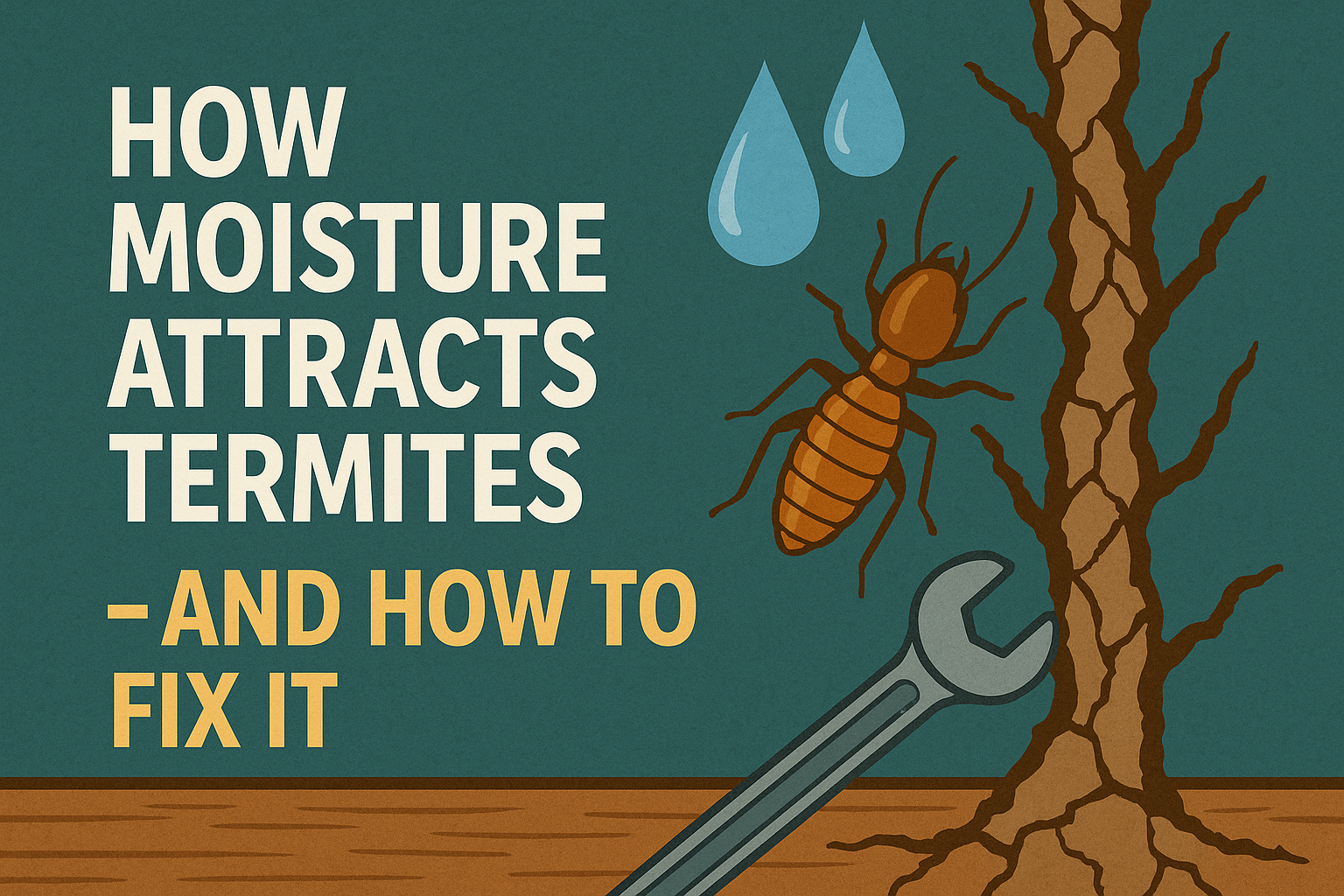Termites are often called “silent destroyers.” They quietly gnaw away at your home’s wooden structures while you’re none the wiser. But did you know moisture plays a leading role in their invasion? In fact, damp conditions are like an open invitation. In this article, we’ll explain why moisture attracts termites and—most importantly—how to eliminate that attraction before they take hold.
1. Why Termites Need Moisture {#why-moisture}
Termites, like us, need water to survive—period. They have thin exoskeletons that can dry out quickly, and moisture also makes their food (wood) easier to eat . Subterranean termites, in particular, depend on constant moisture levels to stay alive and build mud tubes between their underground colonies and your home’s wood.
Moreover, damp wood is softer and richer in nutrients, making it more appetizing—literally—for termites.
 Fun Fact
Fun Fact
Some species like Heterotermes indicola, common in India, prefer timber moisture content above 80–100% and soil moisture around 20–30%.
2. Common Sources of Moisture in and Around Homes
Moisture doesn’t appear out of thin air—it usually stems from everyday household issues. Watch out for these moisture hotspots:
- Leaky Pipes & Plumbing
Drips under sinks or from washing machines can keep areas damp, inviting termites
- Poor Drainage & Gutters
Clogged gutters overflow water, seeping into foundations and wood.
- Crawl Spaces & Basements
Tight, unventilated spaces trap humidity—perfect for termite colonies.
- Foundation‑Adjacent Mulch & Landscaping
Mulch holds moisture close to the house. Throw in shrubs and sprinkler overspray, and you’ve got a termite breeding ground .
- Roof & Chimney Leaks
Missing tiles or cracked chimneys leak rain in, damaging rafters and beams .
- Dampwood & Firewood Storage
Storing firewood directly on soil increases wood moisture and brings termites nearby (preferredpest.com).
3. Termite Species & Their Moisture Preferences
Different termite types have varying moisture tolerances:
| Species | Moisture Need | Habitat/Behavior |
|---|---|---|
| Dampwood | High (moist wood) | Decaying logs |
| Drywood | Low (dry wood) | Above-ground wood |
| Subterranean | Constant moisture | Soil and mud tubes (bbrief.co.za) |
| Heterotermes indicola | Soil 20–30%, timber 80–100% | Indian species |
Understanding species-specific habits helps target prevention strategies.
4. Warning Signs Where Moisture Attracts Termites
Be alert for these red flags:
Mud tubes along foundation walls—built by subterranean termites to stay moist .
Water‑stained or soft wood in floors, beams, or walls .
Buckling floors, sagging walls, bubbled wallpaper—moisture and termite signs combined.
Swarmer termites or discarded wings near cracks, vents, or windows, especially after rain.
Crawl space rot and musty odors, often mistaken for water damage but can be termite-inflicted.
Prompt termite inspections should follow anytime you notice these symptoms.
5. How to Fix Moisture Issues—and Block Termites
1. Improve Drainage & Gutters
Keep gutters clean and downspouts directing water at least 5 ft away from home.
Re-grade around your foundation to encourage water flow away, not toward your house.
2. Repair Plumbing & Roof Leaks
Fix dripping pipes or condensation under sinks.
Seal cracked tiles and patch chimney leaks immediately.
3. Ventilate & Dehumidify
Add vents in crawl spaces and attics.
Use dehumidifiers in damp basements and store firewood off‑ground.
4. Mind Your Mulch & Landscaping
Keep mulch at least 12–18 inches away from foundations, and limit depth to 2–4 inches .
Prune shrubs, mulch lightly, and ensure sprinkler systems don’t soak foundation areas.
5. Seal Cracks & Gaps
Use caulk on foundation gaps, around utility entries, windows, roofs, and plumbing .
6. Treat Moist Wood Properly
Replace rotting wood, and use treated timber when contact with soil is unavoidable.
Borate-treated lumber can deter termites .
6. Integrating Moisture Control with Professional Prevention {#moisture-control}
Scheduled Inspections
Annual termite checkups catch infestation early and help maintain moisture control .
Chemical Barriers & Termite Reticulation System
Professionals often use soil-applied termiticides and Termite Reticulation System around your home to intercept termites.
Ongoing Maintenance
Keep your home dry and termite-free by routinely repainting, re-caulking, cleaning gutters, and inspecting plumbing.
7. Conclusion & FAQ
By tackling moisture proactively, you can shut down a termite’s primary motivation—water. Combine moisture control with routine inspections and professional treatments to keep your home secure.
 FAQ
FAQ
Q1: Can termites live in dry wood if moisture is controlled?
A: Drywood termites can survive with minimal moisture, but they account for fewer infestations. Subterranean species need damp conditions .
Q2: How often should I inspect for termites?
A: At least once a year, but also immediately after floods, plumbing issues, or heavy monsoons.
Q3: Is mulch near my home always risky?
A: Mulch itself isn’t food—but it holds moisture, keeping soil damp under foundations. Keep it light and away from walls to reduce risk.
Q4: What’s the quickest way to make my crawl space termite-resistant?
A: Add a vapor barrier, install vents, dehumidify, remove wood debris, and seal entry points. Combined, these create a hostile environment for termites.
Key Takeaways:
Moisture is termite fuel—remove leaks, puddles, and humidity.
Maintain drainage, ventilation, and landscaping control.
Use treated wood, seal cracks, and store firewood properly.
Combine home maintenance with annual professional inspections and barrier installation.

